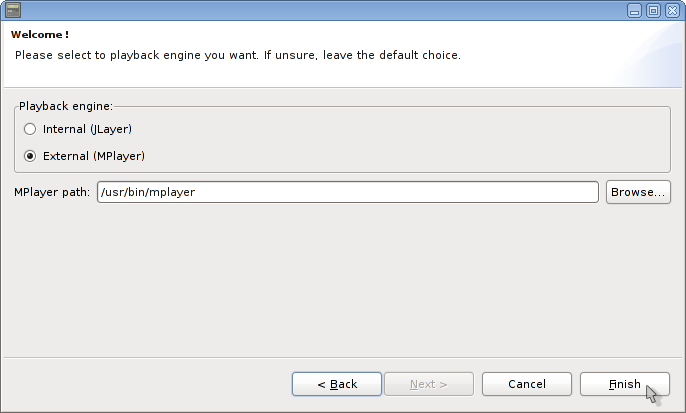Prerequisites
Jampa is made in Java and thus it needs a Java Runtime Environment (JRE).
Also, Jampa can use MPlayer as its playback engine, but MPlayer is not mandatory.
- Windows users
- A JRE can be found here.
- MPlayer is now included in Jampa's installer. If you did not install MPlayer along with Jampa, a Windows MPlayer build can be downloaded from here. This is a simple .zip file, extract it anywhere you wish to, although a standard program location (e.g. something like C:\Program Files) may be a good idea.
- Linux users
- JRE and MPlayer are usually provided by your distribution, try with your favorite package manager.
Intallation
Download Jampa from here.
- Windows users
- Follow the installer steps. Jampa's will be available within the "Start" menu.
- Linux users
- Extract the packge you downloaded at any place that suit you.
- To start Jampa, simply double-click Jampa's main file.
- For ArchLinux users, a PKGBUILD is available through AUR.
First run
At first run, Jampa will run a small wizard, asking for two things: the location of your music library, and the playback engine used to play songs. The first step is to select all the directories you wish to include in your music library.

The second step is to choose the playback engine. At this step, Jampa will try to find MPlayer at some default locations. If succesfull, MPlayer will be proposed as the playback engine. If not, the default built-in playback engine will be proposed.

After this step, Jampa will scan your music library to fill its database. This step can take some times, depending on your music library's size.
Removing Jampa
Simply remove Jampa from where you extracted it.
You will also need to remove Jampa's configuration files. They are all located under a .jampa directory, located in your user's directory (C:\documents and settings\username under Windows, /home/username under Linux).
From source
Jampa is made with Eclipse, using the RCP platform. The best way to build Jampa is to import source code into your Eclipse workspace, either by a downloaded tar-ball, or by doing a SVN checkout.